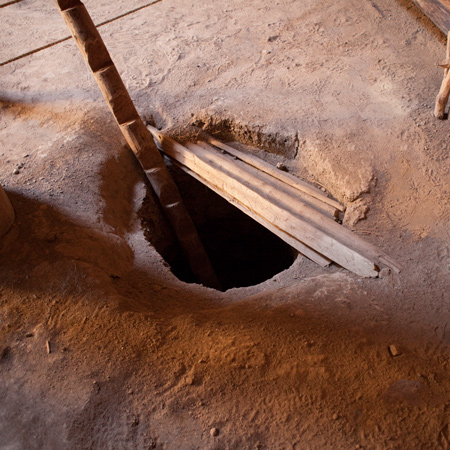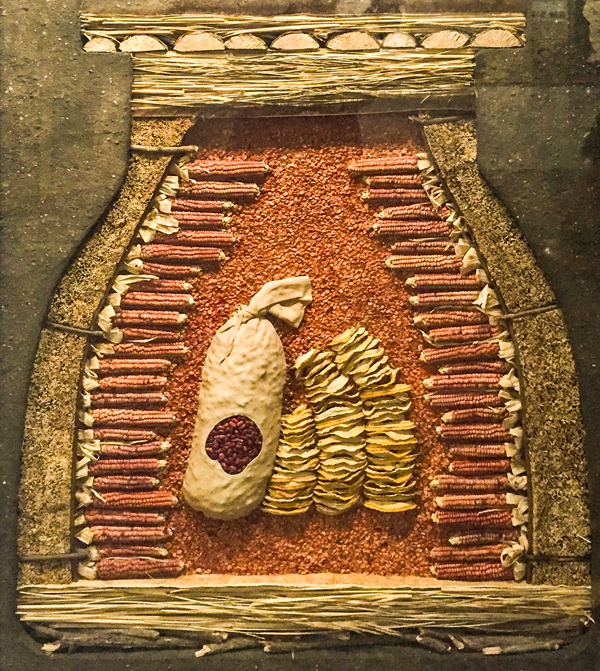At the interpreters‘ camp just outside of Fort Mandan proper, a Mandan man threatens to kill his wife for having slept with Sgt. Ordway. Clark orders the sergeant to give the man some trade goods. Twelve bushels of corn—still on the cob—is brought in.
On the Ouachita River in present Arkansas, Western expedition leader George Hunter has a near-fatal accident.
Stopping Domestic Violence
by Yellowstone Public Radio[1]Originally aired weekdays by Yellowstone Public Radio during the Bicentennial observance of 2003-2006. Narrated by Hal Hansen. Scripts by Whit Hansen and Ed Jacobson. Produced by Leni Holliman. © … Continue reading
Domestic Violence
I was allarmed about 10 oClock by the Sentinal, who informed that an Indian was about to Kill his wife in the interpeters fire about 60 yards below the works . . . . She came to the interpeters fire appearently much beat, & Stabed in 3 places— . . . .
—William Clark
Clark’s Orders
the Husband observed that one of our Serjeants Slept with his wife & if he wanted her he would give her to him, We derected the Serjeant Odway to give the man Some articles
. . . We Derected that no man of this party have any intercourse with this woman under the penelty of Punishment—
—William Clark
Black Cat’s Intervention
at this time the Grand Chief of the nation [Posecopsahe] arrived, & lecturd him, and they both went off apparently dis [Nicholas Biddle:dissatisfied]
The grand Chief continued all day a warm Day fair afternoon— many Indian anickdotes one Chief & his familey Stay all night.
—William Clark
Jusseaume’s Corn
Sgt. Pryor & 5 men Sent with a pearogue [pirogue] to the 2nd village of the mandens [Mandans] for corn . . . . the pearogue returned towards evening with abt. 12 bushels of mixed coullourd corn in ears
—John Ordway
George Hunter Shot
Also on this day, a shooting accident occurs on another of Thomas Jefferson‘s expeditions, this one on the Ouachita River in present Arkansas.
This day I met with an accident that had nearly cost me my Life.
As I thought it prudent to be prepared against any event that might happen from Indians or from any other quarter, I was in the act of loading my pistols & whilst ramming down the ball, I was sitting on a trunk with the pistol between my knees resting its but on the trunk. by the motion of the boat or otherwise it sliped & immediately went off in my face . . . . the charge bruised my forehead & caused two black eyes, & then passed thro my hat within an inch of my right temple & finally thro the roof of the boat. . . . This Accident deprived me of the use of my hand for two weeks so that I could not write . . . .
—George Hunter[2]John F. McDermott, ed., The Western Journals of Dr. George Hunter, 1796–1805 (Philadelphia: American Philosophical Society, 1963), 96.
Weather Diary
Ther. at rise
Weather Wind at rise
Thert. at 4 P.M. Weather Wind at 4 P.M. River 37 fair W 45 fair N W rise ½ in. —Meriwether Lewis[3]To assist the reader, the editor of this web page has omitted the date column, merged the “River” columns, and spelled out some abbreviations.
Fort Mandan is a High Potential Historic Site along the Lewis and Clark National Historic Trail managed by the U.S. National Park Service. The North Dakota Department of Parks and Recreation manages a modern reconstruction and the Lewis and Clark Interpretive Center located at US Hwy 83 and ND Hwy 200A.
Knife River Indian Villages National Historic Site is a High Potential Historic Site along the Lewis and Clark National Historic Trail managed by the U.S. National Park Service. A unit of the National Park System, the site is located at 564 County Road 37, one-half mile north of Stanton, North Dakota. It has exhibits, trails, and a visitor center.
Notes
| ↑1 | Originally aired weekdays by Yellowstone Public Radio during the Bicentennial observance of 2003-2006. Narrated by Hal Hansen. Scripts by Whit Hansen and Ed Jacobson. Produced by Leni Holliman. © 2003 by Yellowstone Public Radio. |
|---|---|
| ↑2 | John F. McDermott, ed., The Western Journals of Dr. George Hunter, 1796–1805 (Philadelphia: American Philosophical Society, 1963), 96. |
| ↑3 | To assist the reader, the editor of this web page has omitted the date column, merged the “River” columns, and spelled out some abbreviations. |
Experience the Lewis and Clark Trail
The Lewis and Clark Trail Experience—our sister site at lewisandclark.travel—connects the world to people and places on the Lewis and Clark Trail.
Discover More
- The Lewis and Clark Expedition: Day by Day by Gary E. Moulton (University of Nebraska Press, 2018). The story in prose, 14 May 1804–23 September 1806.
- The Lewis and Clark Journals: An American Epic of Discovery (abridged) by Gary E. Moulton (University of Nebraska Press, 2003). Selected journal excerpts, 14 May 1804–23 September 1806.
- The Lewis and Clark Journals. by Gary E. Moulton (University of Nebraska Press, 1983–2001). The complete story in 13 volumes.





